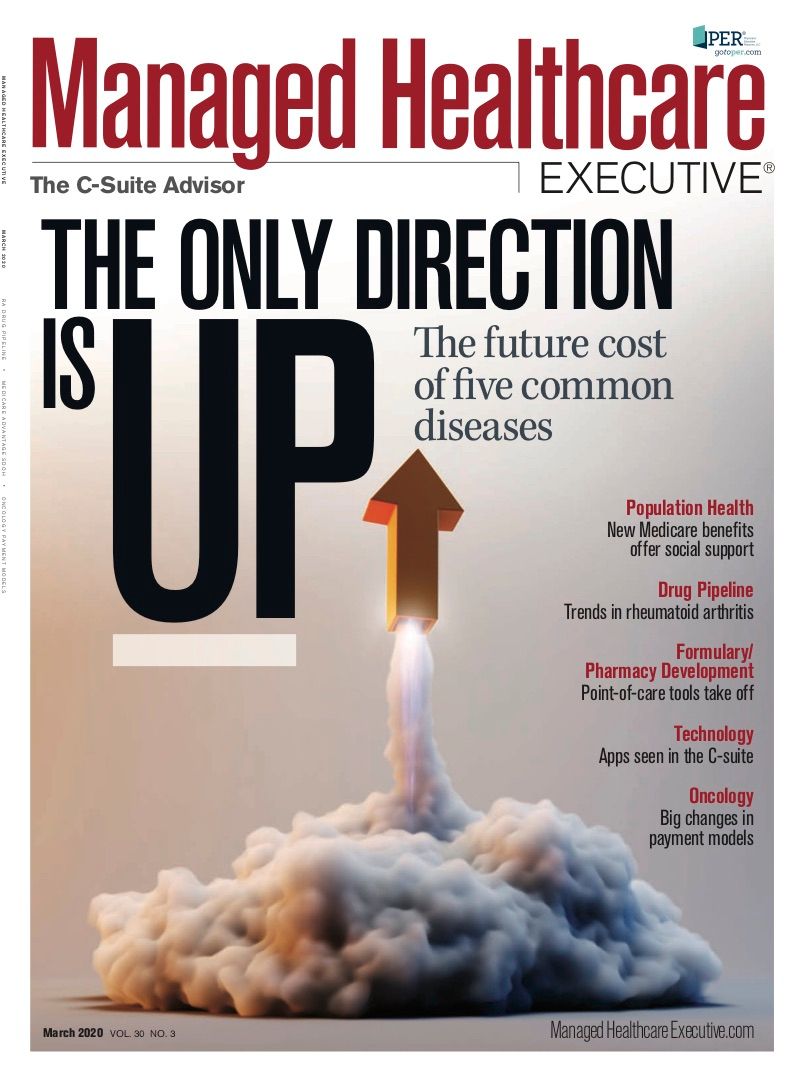Opioid Related Overdoses Decreasing
How two hospitals and two insurers are working to turn the tide of the opioid epidemic.

The opioid epidemic is far from over, but after years of increasing relentlessly, the trendline for the number of drug overdose deaths in the United States finally turned the other direction. According to federal health statistics, there were 67,367 drug overdose deaths in the United States in 2018, a notable 4.1% decline from the 70,237 deaths that occurred in 2017.
The rate of overdose deaths from natural and semisynthetic opioids (oxycodone, hydrocodone) and heroin were lower in 2018 than in 2017. It’s not all good news: The rate for synthetic opioids (fentanyl, tramadol) increased from 2017 to 2018.
Combating the opioid epidemic is a popular cause, and many organizations, government entities, and healthcare groups have responded.
Here are four examples:
Boston Medical Center, Boston
Mothers are more likely to show up for their infants’ check-ups than they are for their own check-ups. It’s a simple maxim followed by clinicians at Boston Medical Center’s Supporting Our Families through Addiction and Recovery-SOFAR, for short-clinic to “hook” mothers into managing their health and maintaining their recovery from dependence on opioids. Launched in July 2017, the program, which is run by largest safety-net hospital in Massachusetts, has seen 200 mother-child pairs since its start.
Related: PBMI2020: Opioid Epidemic Update, Specialty Drugs Rule, And The "Amazonification" Of Health Care
The mother-child pairs are connected to SOFAR through Project RESPECT, another Boston Medical Center program that provides obstetric and substance use disorder treatment for pregnant women and their newborns. While the infant participates in their well-baby visit, in the SOFAR clinic, the mother receives treatment for her dependence on opioids, including access to medication-assisted treatment and a mentor who has been through a similar life experience.
Eileen Costello, MD, chief of ambulatory pediatrics at Boston Medical Center and medical director at SOFAR, and other specially trained pediatricians engage with mothers by asking them about family support, their living situations, and their children. Many of these women are raising children without the help of a partner, notes Costello. Some are living in group homes or struggling with custody issues. If they are taking one of the drugs used in medication-assisted treatment, such as methadone, they often must deal with criticism from family members and others. To help, says Costello, clinicians educate mothers about the research that shows that opioid-dependent women who don’t take methadone or buprenorphine in the prenatal and postpartum periods are at greater risk of relapse in the first year of their child’s life.
The program also supports mothers who are struggling with the shame of potentially having harmed their infant by taking opioids during their pregnancy. SOFAR celebrates their efforts and successes by, for example, recognizing the achievement of arriving at 6 a.m. to get their methadone with an infant in tow, especially during a bitter cold Boston winter.
The greatest challenges with launching the program were associated with overcoming “all the silos” in the hospital setting, says Costello; for example, getting internal medicine and pediatric physicians co-located and tracking clinicians’ time effectively for billing purposes.
Data from the program are collected and analyzed to measure its effect. One finding so far: In its first year, clinicians treated and cured 335 of the mothers with hepatitis C in the SOFAR program, says Costello.
Montefiore Medical Center, the Bronx, N.Y.
Clinicians at Montefiore Medical Center in the Bronx leave the health system’s campus to treat community members with opioid dependence at a nonprofit called New York Harm Reduction Educators. The East Harlem nonprofit uses a harm-reduction approach to opioid abuse that includes providing safe syringes and working to prevent overdoses.
Montefiore clinicians-typically a physician assistant or a medical resident-are embedded into the East Harlem program, and they can serve as a bridge to Montefiore’s primary care services. That translates into access into services ranging from medication-assisted treatment to hepatitis C treatment to pre-exposure prophylaxis for HIV. Montefiore’s commitment to social justice and its Bronx neighborhood-and high cost of addressing healthcare needs when they are dire and need to be treated in the emergency department-helped secure leadership support for the partnership with East Harlem nonprofit, says Brianna Norton, DO, a general internal medicine physician at Montefiore. Seed funding came from New York State, although the program has been self-sustaining since March 2019, when the health system started billing public and private payers.
A typical client is a 50-year-old African American or Latino male, says Norton. Often, the client’s family members live in his country of origin-or have died. Many are homeless and come to the nonprofit to get clean needles or a rapid hepatitis C test. Some just want to take a shower.
Montefiore clinicians saw 118 unique patients in the first three months of the partnership. “These are patients who would otherwise likely never see a physician at all,” observes a spokesperson.
Priority Health, Grand Rapids, Mich.
Michigan has been hit hard by opioid epidemic. In 2017, its opioid overdose death rate was 15th highest in the country.
Christina Barrington, PharmD, vice president of pharmacy programs at Priority Health, Michigan’s second-largest health insurer, says the company is trying to make sure that members have adequate pain relief while also working to prevent accidental overdoses and misuse of opioids. Starting in November 2017, the Grand Rapids, Michigan, nonprofit started limiting access to short-acting opioids for acute pain to a 15-day fill and long-acting opioids for chronic pain to a three-day fill. It also reduced its copay for Narcan (naloxone), the drug for reversing opioid overdoses.
In other moves, Priority Health took steps to reduce opioid dosage to a maximum of 120 MEqD (morphine-equivalent dose) daily and keep track of members who get opioid prescriptions from multiple physicians. a health services.
Barrington says Priority Health has also introduced “pain contracts”: The patient agrees to receive opioid-based medications from a single physician. The physician who signs the contract receives a report of all the doctors who prescribed opioids to their patients. If patients get opioid prescriptions from another physicians, the physician who signed the pain contract can choose to stop treating those patients or taper their medications.
Within one year of launching the program, use of opioids by Priority Health members has declined by 47% among commercial members, 36% among Medicaid members, and 18% among Medicare members.
Capital Blue Cross, Harrisburg, Pa.
Research results published in JAMA Internal Medicine several years ago showed that acupuncture is effective when managing chronic pain. The study focused on patients with nonspecific back or neck pain, shoulder pain, chronic headache, or osteoarthritis. Another study published in JAMA Internal Medicine last year found that acupuncture is helpful as an adjunctive therapy to treat pain associated with chronic stable angina.
Last year, Capital Blue Cross in Harrisburg, Pa., started covering acupuncture to treat pain. More than 200 members “took advantage of the opportunity to use an alternative treatment for their pain,” says Jennifer Chambers, MD, the insurer’s chief medical officer.
“I’m a personal proponent of [acupuncture] to treat chronic neck pain,” adds Chambers, who currently takes no medication for her neck pain. She’s also interested in using acupuncture to treat dry mouth for cancer and heart pain.
“The conclusion here is we need to be more open to nontraditional, non-Western medicine approaches to treating chronic pain,” says Chambers, adding that biofeedback and mindfulness techniques can also help address the anxiety and stress associated with chronic pain.
Aine Cryts is a writer based in Boston.

Extending the Capabilities of the EHR Through Automation
August 2nd 2023Welcome back to another episode of "Tuning In to the C-Suite," where Briana Contreras, an editor of Managed Healthcare Executive, had the pleasure of chatting with Cindy Gaines, chief clinical transformation officer at Lumeon.
Listen
Extending the Capabilities of the EHR Through Automation
August 2nd 2023Welcome back to another episode of "Tuning In to the C-Suite," where Briana Contreras, an editor of Managed Healthcare Executive, had the pleasure of chatting with Cindy Gaines, chief clinical transformation officer at Lumeon.
Listen
2 Commerce Drive
Cranbury, NJ 08512
All rights reserved.